
Archive

Recent Addition, July-August 2016| 1. Economic growth in developing countries: structural transformation, manufacturing and transport infrastructure / Lakhera, Mohan L.- New York: Palgrave Macmillan, 2016 |
|---|
 Abstract: Economic growth across countries during the last 30 years or so has displayed 'dual' divergence between developed and developing countries, and among developing countries. The structural transformation has been either slow or of an anomalous nature. The study addresses these and suggests how they can catch-up with developed world. Abstract: Economic growth across countries during the last 30 years or so has displayed 'dual' divergence between developed and developing countries, and among developing countries. The structural transformation has been either slow or of an anomalous nature. The study addresses these and suggests how they can catch-up with developed world. | | 2. Economic risks of climate change: an American prospectus/ Trevor Houser - New York: Columbia University Press, 2015 | 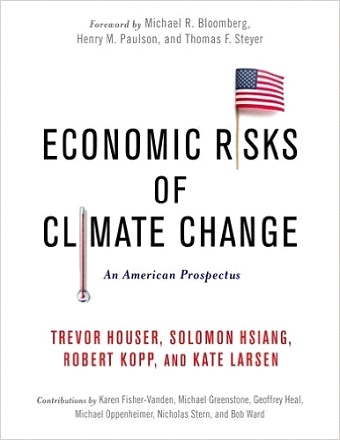 Abstract: Climate change threatens the economy of the United States in myriad ways, including increased flooding and storm damage, altered Crop yields, lost labor productivity, higher crime, reshaped public-health patterns, and strained energy systems, among many other effects. Combining the latest climate models, state-of-the-art econometric research on human responses to climate, and cutting-edge private-sector risk-assessment tools, Economic Risks of Climate Change: An American Prospectus crafts a game-changing profile of the economic risks of climate change in the United States. Abstract: Climate change threatens the economy of the United States in myriad ways, including increased flooding and storm damage, altered Crop yields, lost labor productivity, higher crime, reshaped public-health patterns, and strained energy systems, among many other effects. Combining the latest climate models, state-of-the-art econometric research on human responses to climate, and cutting-edge private-sector risk-assessment tools, Economic Risks of Climate Change: An American Prospectus crafts a game-changing profile of the economic risks of climate change in the United States. | | 3. Emerging Indian multinationals: strategic players in a multipolar world / Edited by Mohan Thite - New York: Oxford University Press, 2016 |  Abstract: Is there a distinctive ‘India way’ of doing business? This query finds resonance not only among corporate leaders but also in academic studies focusing on emerging market multinational enterprises (EMMNEs) in Asia. The speed and spread of EMMNEs has caught the world by surprise, and prompted a need to understand whether, why, and how multinationals from emerging economies are different from the ones in developed countries. Based on comparative data and interviews with over 90 senior managerial personnel from Indian multinationals, this book provides a comprehensive picture of the emerging multinational firms from India in terms of their internationalization process, competitive advantages, approach to global markets, and future outlook. With chapters from leading scholars in the field of international business, Emerging Indian Multinationals throws light on the characteristics, concerns, challenges, and strategies of Indian multinationals from an emerging-market perspective to facilitate crossvergence of best practices for all multinationals in a multipolar world. Abstract: Is there a distinctive ‘India way’ of doing business? This query finds resonance not only among corporate leaders but also in academic studies focusing on emerging market multinational enterprises (EMMNEs) in Asia. The speed and spread of EMMNEs has caught the world by surprise, and prompted a need to understand whether, why, and how multinationals from emerging economies are different from the ones in developed countries. Based on comparative data and interviews with over 90 senior managerial personnel from Indian multinationals, this book provides a comprehensive picture of the emerging multinational firms from India in terms of their internationalization process, competitive advantages, approach to global markets, and future outlook. With chapters from leading scholars in the field of international business, Emerging Indian Multinationals throws light on the characteristics, concerns, challenges, and strategies of Indian multinationals from an emerging-market perspective to facilitate crossvergence of best practices for all multinationals in a multipolar world. | | 4. Emerging power and the UN: what kind of development partnership? / Edited by Thomas G. Weiss and Adriana Erthal Abdenur - London: Routledge, 2016 | 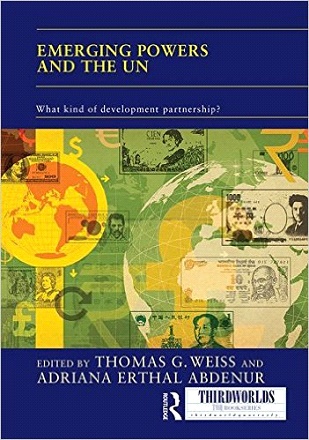 Abstract: The post-2015 sustainable development goals and the changing environment for development cooperation requires a renewed and transformed UN system. In line with their increasing significance as economic powers, a growing number of emerging countries will play an expanded role in the UN system, which could take the form of growing financial contributions, greater presence in governance, higher staff representation, a stronger voice in development deliberations, and a greater overall influence on the development agenda. Abstract: The post-2015 sustainable development goals and the changing environment for development cooperation requires a renewed and transformed UN system. In line with their increasing significance as economic powers, a growing number of emerging countries will play an expanded role in the UN system, which could take the form of growing financial contributions, greater presence in governance, higher staff representation, a stronger voice in development deliberations, and a greater overall influence on the development agenda. | | 5. The Energy security dilemma: US policy and practice / David Bernell and Christopher A. Simon – London: Routledge, 2016 |  Abstract: This book analyzes the energy security of the United States – its ability to obtain reliable, affordable, and sufficient supplies of energy while meeting the goals of achieving environmental sustainability and protecting national security. The economic and national security of the United States is largely dependent upon fossil fuels, especially oil. Without significant changes to current practices and patterns of energy production and use, the domestic and global impacts – security, economic, and environmental – are expected to become worse over the coming decades. Growing US and global energy demands need to be met and the anticipated impacts of climate change must be avoided – all at an affordable price, while avoiding conflict with other nations that have similar goals. Abstract: This book analyzes the energy security of the United States – its ability to obtain reliable, affordable, and sufficient supplies of energy while meeting the goals of achieving environmental sustainability and protecting national security. The economic and national security of the United States is largely dependent upon fossil fuels, especially oil. Without significant changes to current practices and patterns of energy production and use, the domestic and global impacts – security, economic, and environmental – are expected to become worse over the coming decades. Growing US and global energy demands need to be met and the anticipated impacts of climate change must be avoided – all at an affordable price, while avoiding conflict with other nations that have similar goals. | | 6. Engineers of Jihad: the curious connection between violent extremism and education / Gambetta,Diego and Steffen Hertog - Princeton: Princeton University Press, 2016 | 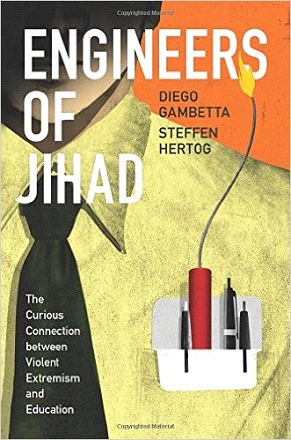 Abstract: The violent actions of a few extremists can alter the course of history, yet there persists a yawning gap between the potential impact of these individuals and what we understand about them. In Engineers of Jihad, Diego Gambetta and Steffen Hertog uncover two unexpected facts, which they imaginatively leverage to narrow that gap: they find that a disproportionate share of Islamist radicals come from an engineering background, and that Islamist and right-wing extremism have more in common than either does with left-wing extremism, in which engineers are absent while social scientists and humanities students are prominent. Abstract: The violent actions of a few extremists can alter the course of history, yet there persists a yawning gap between the potential impact of these individuals and what we understand about them. In Engineers of Jihad, Diego Gambetta and Steffen Hertog uncover two unexpected facts, which they imaginatively leverage to narrow that gap: they find that a disproportionate share of Islamist radicals come from an engineering background, and that Islamist and right-wing extremism have more in common than either does with left-wing extremism, in which engineers are absent while social scientists and humanities students are prominent. | | 7. Environmental policy and politics in the European Union / Delreux and Sander Happaerts - New York: Palgrave Macmillan, 2016 |  Abstract: In recent decades, the European Union has developed one of the world's most stringent sets of environmental policies. These policies cover not only the traditional areas of environmental concern, such as fighting pollution and protecting natural resources, but also increasingly salient issues like GMOs and climate change, which affect day-to-day patterns of production and consumption. As with all areas of policy making within the EU, the creation of environmental policy relies on the co-operation of many political actors – EU institutions, national authorities and interest groups – all with widely differing agendas. Studying how the dynamics between these political actors result in specific environmental policies reveals much about the wider dynamics at play in the EU as a whole. This important new text analyses the European Union's environmental policy, tracing how it has evolved to become today one of its largest fields of action. Using state-of-the-art analysis, it discusses in depth the relationship between policies and the political processes that shape them, and looks at how environmental policies are increasingly having a major impact on other policy fields, including energy, agriculture and transport. Abstract: In recent decades, the European Union has developed one of the world's most stringent sets of environmental policies. These policies cover not only the traditional areas of environmental concern, such as fighting pollution and protecting natural resources, but also increasingly salient issues like GMOs and climate change, which affect day-to-day patterns of production and consumption. As with all areas of policy making within the EU, the creation of environmental policy relies on the co-operation of many political actors – EU institutions, national authorities and interest groups – all with widely differing agendas. Studying how the dynamics between these political actors result in specific environmental policies reveals much about the wider dynamics at play in the EU as a whole. This important new text analyses the European Union's environmental policy, tracing how it has evolved to become today one of its largest fields of action. Using state-of-the-art analysis, it discusses in depth the relationship between policies and the political processes that shape them, and looks at how environmental policies are increasingly having a major impact on other policy fields, including energy, agriculture and transport. | | 8. Ethnic conflict & protest in Tibet & Xinjiang: unrest in China's west / Edited by Ben Hillman and Gray Tuttle – New York: Columbia University Press, 2016 |  Abstract: Despite more than a decade of rapid economic development, rising living standards, and large-scale improvements in infrastructure and services, China's western borderlands are awash in a wave of ethnic unrest not seen since the 1950s. Through on-the-ground interviews and firsthand observations, the international experts in this volume create an invaluable record of the conflicts and protests as they have unfolded―the most extensive chronicle of events to date. The authors examine the factors driving the unrest in Tibet and Xinjiang and the political strategies used to suppress them. They also explain why certain areas have seen higher concentrations of ethnic-based violence than others. Essential reading for anyone struggling to understand the origins of unrest in contemporary Tibet and Xinjiang, this volume considers the role of propaganda and education as generators and sources of conflict. It links interethnic strife to economic growth and connects environmental degradation to increased instability. It captures the subtle difference between violence in urban Xinjiang and conflict in rural Tibet, with detailed portraits of everyday individuals caught among the pressures of politics, history, personal interest, and global movements with local resonance. Abstract: Despite more than a decade of rapid economic development, rising living standards, and large-scale improvements in infrastructure and services, China's western borderlands are awash in a wave of ethnic unrest not seen since the 1950s. Through on-the-ground interviews and firsthand observations, the international experts in this volume create an invaluable record of the conflicts and protests as they have unfolded―the most extensive chronicle of events to date. The authors examine the factors driving the unrest in Tibet and Xinjiang and the political strategies used to suppress them. They also explain why certain areas have seen higher concentrations of ethnic-based violence than others. Essential reading for anyone struggling to understand the origins of unrest in contemporary Tibet and Xinjiang, this volume considers the role of propaganda and education as generators and sources of conflict. It links interethnic strife to economic growth and connects environmental degradation to increased instability. It captures the subtle difference between violence in urban Xinjiang and conflict in rural Tibet, with detailed portraits of everyday individuals caught among the pressures of politics, history, personal interest, and global movements with local resonance. | | 9. EU Environmental law, international environmental law and human rights law: the case of environmental responsibility / Gouritin, Armelle - Boston: Nijhoff, 2016 |  Abstract: In EU Environmental Law, International Environmental Law, and Human Rights Law: The Case of Environmental Responsibility, Armelle Gouritin offers a critical appraisal of EU environmental responsibility law and asserts a new rights-based approach to international environmental law. This book addresses environmental damage, environmental harm, the grounds for environmental responsibility and the exceptions to the responsibility principle. A critical appraisal of EU Directives 2004/35 and 2008/99 is complemented by an analysis of the input of the European Court on Human Rights and international environmental law with a view to filling the gaps identified in the Directives. Gouritin offers a full analysis of the potential and limits of the rights-based approach applied to environmental responsibility. Abstract: In EU Environmental Law, International Environmental Law, and Human Rights Law: The Case of Environmental Responsibility, Armelle Gouritin offers a critical appraisal of EU environmental responsibility law and asserts a new rights-based approach to international environmental law. This book addresses environmental damage, environmental harm, the grounds for environmental responsibility and the exceptions to the responsibility principle. A critical appraisal of EU Directives 2004/35 and 2008/99 is complemented by an analysis of the input of the European Court on Human Rights and international environmental law with a view to filling the gaps identified in the Directives. Gouritin offers a full analysis of the potential and limits of the rights-based approach applied to environmental responsibility. | | 10. Facing China as a new global superpower: domestic and international dynamics from a multidisciplinary angle / by Huhua Cao and Jeremy Paltiel - New York: Springers, 2016 |  Abstract: This book brings together diverse perspectives from the newest generation of scholars from Canada and China to better understand China in the 21st century. It examines China's socio-political structure, its particular relationship with Canada, and interaction with the international community; and discusses how to overcome the ideological differences between the two countries to establish positive and sustainable Canada-China bilateral relations for the future. Importantly, the perspectives are from young authors, with a different relationship to China (and Canada) than more established authors. This compilation helps breathe new life into the study of Sino-Canada relations from both countries, and to reassess and re-frame issues related to China in the 21st century. Abstract: This book brings together diverse perspectives from the newest generation of scholars from Canada and China to better understand China in the 21st century. It examines China's socio-political structure, its particular relationship with Canada, and interaction with the international community; and discusses how to overcome the ideological differences between the two countries to establish positive and sustainable Canada-China bilateral relations for the future. Importantly, the perspectives are from young authors, with a different relationship to China (and Canada) than more established authors. This compilation helps breathe new life into the study of Sino-Canada relations from both countries, and to reassess and re-frame issues related to China in the 21st century. | | 11. Fault lines: how hidden fractures still threaten the world economy / Raghuram G. Rajan - Princeton: Princeton University Press, 2010 |  Abstract: Raghuram Rajan was one of the few economists who warned of the global financial crisis before it hit. Now, as the world struggles to recover, it's tempting to blame what happened on just a few greedy bankers who took irrational risks and left the rest of us to foot the bill. In Fault Lines, Rajan argues that serious flaws in the economy are also to blame, and warns that a potentially more devastating crisis awaits us if they aren't fixed. Rajan shows how the individual choices that collectively brought about the economic meltdown--made by bankers, government officials, and ordinary homeowners--were rational responses to a flawed global financial order in which the incentives to take on risk are incredibly out of step with the dangers those risks pose. He traces the deepening fault lines in a world overly dependent on the indebted American consumer to power global economic growth and stave off global downturns. He exposes a system where America's growing inequality and thin social safety net create tremendous political pressure to encourage easy credit and keep job creation robust, no matter what the consequences to the economy's long-term health; and where the U.S. financial sector, with its skewed incentives, is the critical but unstable link between an overstimulated America and an underconsuming world. In Fault Lines, Rajan demonstrates how unequal access to education and health care in the United States puts us all in deeper financial peril, even as the economic choices of countries like Germany, Japan, and China place an undue burden on America to get its policies right. He outlines the hard choices we need to make to ensure a more stable world economy and restore lasting prosperity. Abstract: Raghuram Rajan was one of the few economists who warned of the global financial crisis before it hit. Now, as the world struggles to recover, it's tempting to blame what happened on just a few greedy bankers who took irrational risks and left the rest of us to foot the bill. In Fault Lines, Rajan argues that serious flaws in the economy are also to blame, and warns that a potentially more devastating crisis awaits us if they aren't fixed. Rajan shows how the individual choices that collectively brought about the economic meltdown--made by bankers, government officials, and ordinary homeowners--were rational responses to a flawed global financial order in which the incentives to take on risk are incredibly out of step with the dangers those risks pose. He traces the deepening fault lines in a world overly dependent on the indebted American consumer to power global economic growth and stave off global downturns. He exposes a system where America's growing inequality and thin social safety net create tremendous political pressure to encourage easy credit and keep job creation robust, no matter what the consequences to the economy's long-term health; and where the U.S. financial sector, with its skewed incentives, is the critical but unstable link between an overstimulated America and an underconsuming world. In Fault Lines, Rajan demonstrates how unequal access to education and health care in the United States puts us all in deeper financial peril, even as the economic choices of countries like Germany, Japan, and China place an undue burden on America to get its policies right. He outlines the hard choices we need to make to ensure a more stable world economy and restore lasting prosperity. | | 12. Free Speech: ten principles for a connected world /Timothy Garton Ash - London: Yale University Press, 2016 | 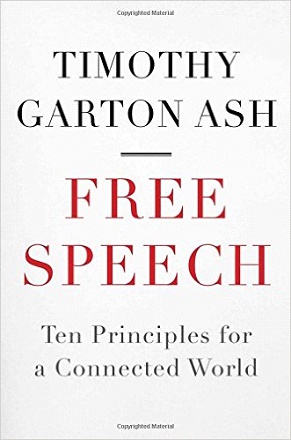 Abstract: Never in human history was there such a chance for freedom of expression. If we have Internet access, any one of us can publish almost anything we like and potentially reach an audience of millions. Never was there a time when the evils of unlimited speech flowed so easily across frontiers: violent intimidation, gross violations of privacy, tidal waves of abuse. A pastor burns a Koran in Florida and UN officials die in Afghanistan. Drawing on a lifetime of writing about dictatorships and dissidents, Timothy Garton Ash argues that in this connected world that he calls cosmopolis, the way to combine freedom and diversity is to have more but also better free speech. Across all cultural divides we must strive to agree on how we disagree. He draws on a thirteen-language global online project—freespeechdebate.com—conducted out of Oxford University and devoted to doing just that. With vivid examples, from his personal experience of China's Orwellian censorship apparatus to the controversy around Charlie Hebdo to a very English court case involving food writer Nigella Lawson, he proposes a framework for civilized conflict in a world where we are all becoming neighbors. Abstract: Never in human history was there such a chance for freedom of expression. If we have Internet access, any one of us can publish almost anything we like and potentially reach an audience of millions. Never was there a time when the evils of unlimited speech flowed so easily across frontiers: violent intimidation, gross violations of privacy, tidal waves of abuse. A pastor burns a Koran in Florida and UN officials die in Afghanistan. Drawing on a lifetime of writing about dictatorships and dissidents, Timothy Garton Ash argues that in this connected world that he calls cosmopolis, the way to combine freedom and diversity is to have more but also better free speech. Across all cultural divides we must strive to agree on how we disagree. He draws on a thirteen-language global online project—freespeechdebate.com—conducted out of Oxford University and devoted to doing just that. With vivid examples, from his personal experience of China's Orwellian censorship apparatus to the controversy around Charlie Hebdo to a very English court case involving food writer Nigella Lawson, he proposes a framework for civilized conflict in a world where we are all becoming neighbors. | | 13. From cold war to cyber war: the evolution of the international law of peace and armed conflict over the last 25 years by Hans- Joachim Heintze and Pierre Thielborger - New York: Springer, 2016 | 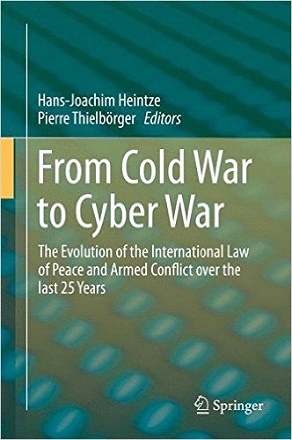 Abstract: This book follows the history of the international law of peace and armed conflict over the last 25 years. It highlights both the parameters that have remained the same over the years as well as the new challenges now facing international law. The articles analyze new developments concerning the prohibition of the use of force in international relations, self-determination of peoples, human rights and human security as well as international coordination of humanitarian assistance Abstract: This book follows the history of the international law of peace and armed conflict over the last 25 years. It highlights both the parameters that have remained the same over the years as well as the new challenges now facing international law. The articles analyze new developments concerning the prohibition of the use of force in international relations, self-determination of peoples, human rights and human security as well as international coordination of humanitarian assistance | | 14. From the first world war to Arab spring: what's really going on in the middle east? /M. E. McMillan - New York: Palgrave Macmillan, 2016 | 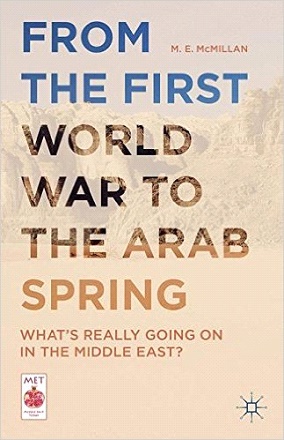 Abstract: Starting from the events surrounding the First World War, the author traces the history of the modern Middle East and puts the Arab Spring into context. McMillan breaks down the nuances of Western involvement in the Middle East, alliances and divisions between Middle Eastern peoples and nations, and the role of religion in these conflicts. Abstract: Starting from the events surrounding the First World War, the author traces the history of the modern Middle East and puts the Arab Spring into context. McMillan breaks down the nuances of Western involvement in the Middle East, alliances and divisions between Middle Eastern peoples and nations, and the role of religion in these conflicts. | | 15. Gandhi and Tagore: politics, truth and conscience / Gangeya Mukherji - London: Routledge, 2016 |  Abstract: This book brings together the political thought of Gandhi and Tagore to examine the relationship between politics, truth and conscience. It explores truth and conscience as viable public virtues with regard to two exemplars of ethical politics, addressing in turn the concerns of an evolving modern Indian political community. The comprehensive and textually argued discussion frames the subject of the validity of ethical politics in inhospitable contexts such as the fanatically despotic state and energised nationalism. The book studies in nuanced detail Tagore’s opposition to political violence in colonial Bengal, the scope of non-violence and - Satyagraha_ as recommended by Gandhi to Jews in Nazi Germany, his response to the complexity of protest against the Jallianwala Bagh massacre, and the differently constituted nationalism of Gandhi and Tagore. It presents their famous debate in a new light, embedded within the dynamics of cultural identification, political praxis and the capacity of a community to imbibe the principles of ethical politics. Comprehensive and perceptive in analysis, this book will be a valuable addition for scholars and researchers of political science with specialisation in Indian political thought, philosophy and history. Gangeya Mukherji is Reader in English at Mahamati Prannath Mahavidyalaya, Mau-Chitrakoot, Uttar Pradesh, India Abstract: This book brings together the political thought of Gandhi and Tagore to examine the relationship between politics, truth and conscience. It explores truth and conscience as viable public virtues with regard to two exemplars of ethical politics, addressing in turn the concerns of an evolving modern Indian political community. The comprehensive and textually argued discussion frames the subject of the validity of ethical politics in inhospitable contexts such as the fanatically despotic state and energised nationalism. The book studies in nuanced detail Tagore’s opposition to political violence in colonial Bengal, the scope of non-violence and - Satyagraha_ as recommended by Gandhi to Jews in Nazi Germany, his response to the complexity of protest against the Jallianwala Bagh massacre, and the differently constituted nationalism of Gandhi and Tagore. It presents their famous debate in a new light, embedded within the dynamics of cultural identification, political praxis and the capacity of a community to imbibe the principles of ethical politics. Comprehensive and perceptive in analysis, this book will be a valuable addition for scholars and researchers of political science with specialisation in Indian political thought, philosophy and history. Gangeya Mukherji is Reader in English at Mahamati Prannath Mahavidyalaya, Mau-Chitrakoot, Uttar Pradesh, India | | 16. The gates of Europe: a history of Ukraine Sehii Plokhy - New York: Basic Books, 2015 | 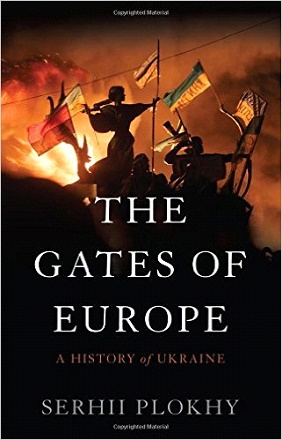 Abstract: Ukraine is currently embroiled in a tense fight with Russia to preserve its territorial integrity and political independence. But today’s conflict is only the latest in a long history of battles over Ukraine’s territory and its existence as a sovereign nation. As the award-winning historian Serhii Plokhy argues in The Gates of Europe, we must examine Ukraine’s past in order to understand its present and future. Situated between Central Europe, Russia, and the Middle East, Ukraine was shaped by the empires that used it as a strategic gateway between East and West—from the Roman and Ottoman empires to the Third Reich and the Soviet Union. For centuries, Ukraine has been a meeting place of various cultures. The mixing of sedentary and nomadic peoples and Christianity and Islam on the steppe borderland produced the class of ferocious warriors known as the Cossacks, for example, while the encounter between the Catholic and Orthodox churches created a religious tradition that bridges Western and Eastern Christianity. Ukraine has also been a home to millions of Jews, serving as the birthplace of Hassidism—and as one of the killing fields of the Holocaust. Plokhy examines the history of Ukraine’s search for its identity through the lives of the major figures in Ukrainian history: Prince Yaroslav the Wise of Kyiv, whose daughter Anna became queen of France; the Cossack ruler Ivan Mazepa, who was immortalized in the poems of Byron and Pushkin; Nikita Khrushchev and his protégé-turned-nemesis Leonid Brezhnev, who called Ukraine their home; and the heroes of the Maidan protests of 2013 and 2014, who embody the current struggle over Ukraine’s future. Abstract: Ukraine is currently embroiled in a tense fight with Russia to preserve its territorial integrity and political independence. But today’s conflict is only the latest in a long history of battles over Ukraine’s territory and its existence as a sovereign nation. As the award-winning historian Serhii Plokhy argues in The Gates of Europe, we must examine Ukraine’s past in order to understand its present and future. Situated between Central Europe, Russia, and the Middle East, Ukraine was shaped by the empires that used it as a strategic gateway between East and West—from the Roman and Ottoman empires to the Third Reich and the Soviet Union. For centuries, Ukraine has been a meeting place of various cultures. The mixing of sedentary and nomadic peoples and Christianity and Islam on the steppe borderland produced the class of ferocious warriors known as the Cossacks, for example, while the encounter between the Catholic and Orthodox churches created a religious tradition that bridges Western and Eastern Christianity. Ukraine has also been a home to millions of Jews, serving as the birthplace of Hassidism—and as one of the killing fields of the Holocaust. Plokhy examines the history of Ukraine’s search for its identity through the lives of the major figures in Ukrainian history: Prince Yaroslav the Wise of Kyiv, whose daughter Anna became queen of France; the Cossack ruler Ivan Mazepa, who was immortalized in the poems of Byron and Pushkin; Nikita Khrushchev and his protégé-turned-nemesis Leonid Brezhnev, who called Ukraine their home; and the heroes of the Maidan protests of 2013 and 2014, who embody the current struggle over Ukraine’s future. | | 17. Global migration: patterns, processes, and politics / Elizabeth Mavroudi and Caroline Nagel - London: Routledge, 2016 | 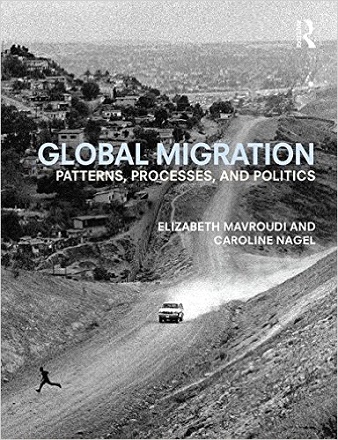 Abstract: Global Migration provides a clear, concise, and well-organized discussion of historical patterns and contemporary trends of migration, while guiding the readers through an often difficult and politicised topic. Aimed primarily at undergraduate and Master’s students, the text encourages the readers to reflect on economic processes, politics, immigrant lives and raises debates about inclusion, exclusion, and citizenship. The text critically highlights the global character of contemporary migration and the importance of historical context to current processes and emphasises the role of gender, race and national ideologies in shaping migration experiences. Abstract: Global Migration provides a clear, concise, and well-organized discussion of historical patterns and contemporary trends of migration, while guiding the readers through an often difficult and politicised topic. Aimed primarily at undergraduate and Master’s students, the text encourages the readers to reflect on economic processes, politics, immigrant lives and raises debates about inclusion, exclusion, and citizenship. The text critically highlights the global character of contemporary migration and the importance of historical context to current processes and emphasises the role of gender, race and national ideologies in shaping migration experiences. | | 18. Global responses to maritime violence /Edited by Paul Shemella - California: Stanford Security Studies 2016 |  Abstract: Global Responses to Maritime Violence is a full discussion of maritime security short of war that goes beyond the current literature in both scope and perspective. The chapters in this volume examine terrorism, piracy, armed robbery at sea, illegal maritime trafficking, illegal fishing, and other maritime crimes. Contributors uncover both threats and responses as a complex ecosystem that challenges even the strongest national and regional institutions. Managing this system is a "wicked problem" that has no ultimate solution. But the book offers strategic precepts to guide the efforts of any government that seeks to improve its responses to maritime violence. The bottom line is that maritime violence can be managed effectively enough to protect citizens and national economies that depend on the sea. Comprehensive in scope, the volume coheres around the premise that good governance in the maritime domain, though difficult, is worth the considerable resources required. Abstract: Global Responses to Maritime Violence is a full discussion of maritime security short of war that goes beyond the current literature in both scope and perspective. The chapters in this volume examine terrorism, piracy, armed robbery at sea, illegal maritime trafficking, illegal fishing, and other maritime crimes. Contributors uncover both threats and responses as a complex ecosystem that challenges even the strongest national and regional institutions. Managing this system is a "wicked problem" that has no ultimate solution. But the book offers strategic precepts to guide the efforts of any government that seeks to improve its responses to maritime violence. The bottom line is that maritime violence can be managed effectively enough to protect citizens and national economies that depend on the sea. Comprehensive in scope, the volume coheres around the premise that good governance in the maritime domain, though difficult, is worth the considerable resources required. | | 19. The global rise of China /So and Yin-Wah Chu - UK: Polity Press, 2016 |  Abstract: This book sets out to unravel and explain the puzzle of the global rise of China: how, in just forty years, China has been quickly transformed from a poor, backward third-world country to one of the world’s core economic powerhouses. Exactly how did this Chinese developmental miracle happen? Focusing on the key historical turning point in China’s post-socialist development, the book examines the complex processes through which China interacted with the global neoliberal project of the late twentieth century. Alvin Y. So and Yin-Wah Chu reveal the centrality of the communist party-state in propelling China onto the world scene, and how it has successfully responded to the developmental challenges of technological upgrading, environmental degradation, inter-state rivalry, and maintaining its power. This book provides a comprehensive and insightful study of the rise of China not solely from an economic, social, and political perspective, but also from a global and historical perspective. It will be an invaluable guide for students and non-specialists interested in post-socialist development and the global rise of China in the twenty-first century. Abstract: This book sets out to unravel and explain the puzzle of the global rise of China: how, in just forty years, China has been quickly transformed from a poor, backward third-world country to one of the world’s core economic powerhouses. Exactly how did this Chinese developmental miracle happen? Focusing on the key historical turning point in China’s post-socialist development, the book examines the complex processes through which China interacted with the global neoliberal project of the late twentieth century. Alvin Y. So and Yin-Wah Chu reveal the centrality of the communist party-state in propelling China onto the world scene, and how it has successfully responded to the developmental challenges of technological upgrading, environmental degradation, inter-state rivalry, and maintaining its power. This book provides a comprehensive and insightful study of the rise of China not solely from an economic, social, and political perspective, but also from a global and historical perspective. It will be an invaluable guide for students and non-specialists interested in post-socialist development and the global rise of China in the twenty-first century. | | 20. Global rogues and regional orders: the multidimensional challenge of North Korea and Iran / Hyun Cho - New York: Oxford University Press, 2016 |  Abstract: Why do some regional actors cooperate with the United States over the North Korean and Iranian nuclear questions, while others do not? What are the implications of such varying responses for regional order and global security? This book explores the causes and consequences of the regional perceptions and policies with regard to the North Korean and Iranian challenges. Lacking in existing studies on proliferation in general and the North Korean and Iranian crises in particular is a realization that global efforts to address the nuclear challenges have coincided with a shift in the regional landscape in East Asia and the Middle East. This book argues that the regional role conceptions of North Korea’s and Iran’s neighbors—the pursuit of new regional roles and status in the changing regional and global environments—shape regional actors’ threat perceptions and policy preferences vis-à-vis North Korea and Iran. The U.S. frame of North Korea and Iran as archetypical global rogues is fundamentally at odds with the regional debate centered on multiple understandings of what North Korea and Iran respectively mean for the regional order. As a result, while some regional actors, such as Israel, Saudi Arabia, and Japanese conservatives, side with the United States, others seek to challenge, or dissociate from, the U.S. position as a means to enhance their countries’ regional role and foreign policy autonomy. Such political contestation over North Korea and Iran in turn shapes the regional order by influencing alliance relations and regional cooperation in East Asia and the Middle East. Abstract: Why do some regional actors cooperate with the United States over the North Korean and Iranian nuclear questions, while others do not? What are the implications of such varying responses for regional order and global security? This book explores the causes and consequences of the regional perceptions and policies with regard to the North Korean and Iranian challenges. Lacking in existing studies on proliferation in general and the North Korean and Iranian crises in particular is a realization that global efforts to address the nuclear challenges have coincided with a shift in the regional landscape in East Asia and the Middle East. This book argues that the regional role conceptions of North Korea’s and Iran’s neighbors—the pursuit of new regional roles and status in the changing regional and global environments—shape regional actors’ threat perceptions and policy preferences vis-à-vis North Korea and Iran. The U.S. frame of North Korea and Iran as archetypical global rogues is fundamentally at odds with the regional debate centered on multiple understandings of what North Korea and Iran respectively mean for the regional order. As a result, while some regional actors, such as Israel, Saudi Arabia, and Japanese conservatives, side with the United States, others seek to challenge, or dissociate from, the U.S. position as a means to enhance their countries’ regional role and foreign policy autonomy. Such political contestation over North Korea and Iran in turn shapes the regional order by influencing alliance relations and regional cooperation in East Asia and the Middle East. | | 21. The great exception: the new deal & the limits of American politics /Jefferson Cowie - Princeton: Princeton University Press, 2016 | 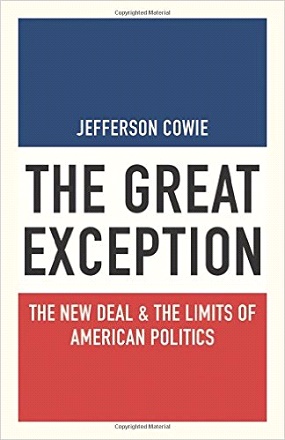 Abstract:The New Deal: where does it fit in the big picture of American history? What does it mean for us today? What happened to the economic equality it once engendered? In The Great Exception, Jefferson Cowie provides new answers to these big questions. Beginning in the Great Depression and through to the 1970s, he argues, the United States built a uniquely equitable period that contrasts with the deeper historical patterns of American political practice, economic structure, and cultural outlook. During those exceptional decades, which Cowie situates in the long arc of American history, the government used its considerable resources on behalf of working Americans in ways that it had not before and has not since. The crises of the Depression and World War II forced realignments of American politics and class relations, but these changes were less a permanent triumph of the welfare state than the product of a temporary cessation of enduring tensions involving race, immigration, culture, class, and individualism. Against this backdrop, Cowie shows how any renewed American battle for collective economic rights needs to build on an understanding of how the New Deal was won--and how it ultimately succumbed to contrasting patterns ingrained in U.S. history. As positive as the era of Roosevelt was in creating a more equitable society, Cowie suggests that the New Deal may necessarily belong more to the past than the future of American politics. Anyone who wants to come to terms with the politics of inequality in U.S. history will need to read The Great Exception. Abstract:The New Deal: where does it fit in the big picture of American history? What does it mean for us today? What happened to the economic equality it once engendered? In The Great Exception, Jefferson Cowie provides new answers to these big questions. Beginning in the Great Depression and through to the 1970s, he argues, the United States built a uniquely equitable period that contrasts with the deeper historical patterns of American political practice, economic structure, and cultural outlook. During those exceptional decades, which Cowie situates in the long arc of American history, the government used its considerable resources on behalf of working Americans in ways that it had not before and has not since. The crises of the Depression and World War II forced realignments of American politics and class relations, but these changes were less a permanent triumph of the welfare state than the product of a temporary cessation of enduring tensions involving race, immigration, culture, class, and individualism. Against this backdrop, Cowie shows how any renewed American battle for collective economic rights needs to build on an understanding of how the New Deal was won--and how it ultimately succumbed to contrasting patterns ingrained in U.S. history. As positive as the era of Roosevelt was in creating a more equitable society, Cowie suggests that the New Deal may necessarily belong more to the past than the future of American politics. Anyone who wants to come to terms with the politics of inequality in U.S. history will need to read The Great Exception. | | 22. The Gulf states in international political economy / Kristian Coates Ulrichsen - New York: Palgrave Macmillan, 2016 |  Abstract: Kristian Coates Ulrichsen examines the changing position of the Gulf Cooperation Council states within a global order which itself is in a state of flux. Against the backdrop of deep shifts in the structure and balance of geo-political and geo-economic gravity, the Gulf States have become increasingly assertive centres of regional power and influence and imprinted themselves on the global consciousness, their exposure magnified by the acquisition or sponsorship of landmark assets and prestige events across the world. Moving far beyond the longstanding role of Saudi Arabia in stabilizing international oil markets, in the 2000s the Gulf States emerged as more muscular participants in attempts to rebalance and reshape the world around them. This process accelerated after the sudden outbreak of the Arab Spring in 2011 as the Gulf States took unprecedented measures to contain and control the processes of change throughout the Middle East and North Africa. Abstract: Kristian Coates Ulrichsen examines the changing position of the Gulf Cooperation Council states within a global order which itself is in a state of flux. Against the backdrop of deep shifts in the structure and balance of geo-political and geo-economic gravity, the Gulf States have become increasingly assertive centres of regional power and influence and imprinted themselves on the global consciousness, their exposure magnified by the acquisition or sponsorship of landmark assets and prestige events across the world. Moving far beyond the longstanding role of Saudi Arabia in stabilizing international oil markets, in the 2000s the Gulf States emerged as more muscular participants in attempts to rebalance and reshape the world around them. This process accelerated after the sudden outbreak of the Arab Spring in 2011 as the Gulf States took unprecedented measures to contain and control the processes of change throughout the Middle East and North Africa. | | 23. Hamas: terrorism, governance, and its future in middle east politics / Jennifer Jefferis - California: Praeger, 2016 | 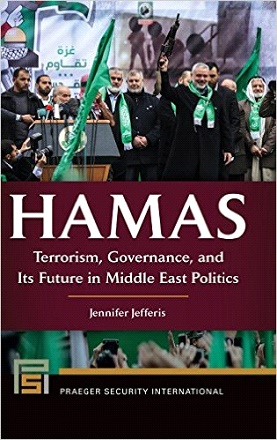 Abstract: Structured around key elements at the regional, political, institutional, and personal levels of analysis, this is a complete and forward-leaning view of Hamas that provides a deep and detailed examination of the history, ideology, political prospects, and regional opportunities of an often poorly understood organization that is redefining 21st-century terrorism. Abstract: Structured around key elements at the regional, political, institutional, and personal levels of analysis, this is a complete and forward-leaning view of Hamas that provides a deep and detailed examination of the history, ideology, political prospects, and regional opportunities of an often poorly understood organization that is redefining 21st-century terrorism.
- Provides a detailed and contemporary look at an influential organization that has enormous potential to shape the role that radicalized Islam will play in the Middle East over the next decade
- Enables a deeper understanding of how Hamas is poised―in light of its ideological, political, and military objectives―to influence the development of the Middle East region in the coming years
- Offers insightful new analysis about Hamas' approach to violence and political engagement that identifies what their methodologies can tell us about violent non-state actors, political engagement, and regional alliances of the future, and predicts whether policymakers' and strategists' future efforts to engage (or not engage) with radical political parties will likely be effective.
| | 24. The Himalayas and India-China relations / Devendra Nath Panigrahi - London: Routledge, 2016 |  Abstract: This book provides a systematic analysis of China's rise to power. It traces the complex contours of its relation with India, with the Himalayas prominently figuring in the discourse. Drawing on myths, legends, classical literature, archival resources and contemporary political and international affairs, it brings to the fore several critical issues integral to India–China relations. It also studies the two nations in terms of trade across borders, exchange of ideas and confluence of diverse cultures, imperial strategic rivalries in the colonial period, and recent military skirmishes and diplomatic interaction. Lucid and explanatory, this volume will interest scholars and researchers in international relations, history, political science and area studies specially those interested in the geopolitics of India and China. Abstract: This book provides a systematic analysis of China's rise to power. It traces the complex contours of its relation with India, with the Himalayas prominently figuring in the discourse. Drawing on myths, legends, classical literature, archival resources and contemporary political and international affairs, it brings to the fore several critical issues integral to India–China relations. It also studies the two nations in terms of trade across borders, exchange of ideas and confluence of diverse cultures, imperial strategic rivalries in the colonial period, and recent military skirmishes and diplomatic interaction. Lucid and explanatory, this volume will interest scholars and researchers in international relations, history, political science and area studies specially those interested in the geopolitics of India and China. | | 25. Historiography in the modern world: Western and Indian perspectives / Shashi Bhushan Upadhyay - New York: Oxford University Press, 2016 |  Abstract: This book is primarily concerned with the emergence, growth, climax and partial decline of modernity in historical thoughts and writings, with particular reference to Europe and India. This is done by examining relatively more organized forms of historical thoughts and their expression in historical writings since the Renaissance in Europe and from the late eighteenth century in India. The pre-modern histories are discussed to underline the then prevailing diversity in the representation of past as well as to trace the line of descent to modern historiography. This book analytically takes into account a wide range of historiographical trends over a very long period of time. Abstract: This book is primarily concerned with the emergence, growth, climax and partial decline of modernity in historical thoughts and writings, with particular reference to Europe and India. This is done by examining relatively more organized forms of historical thoughts and their expression in historical writings since the Renaissance in Europe and from the late eighteenth century in India. The pre-modern histories are discussed to underline the then prevailing diversity in the representation of past as well as to trace the line of descent to modern historiography. This book analytically takes into account a wide range of historiographical trends over a very long period of time. | | 26. History and international relations: from the ancient world to the 21st century / Howard Leroy Malchow –London: Bloomsbury, 2016 |  Abstract: History and International Relations examines, from a historian's perspective, the evolution of international relations as a discipline and charts its engagement with the history of war, peace, and foreign relations from the ancient world to the present day. In three parts, it looks at the field's development, its contribution to historical narrative, and its contemporary practice: Abstract: History and International Relations examines, from a historian's perspective, the evolution of international relations as a discipline and charts its engagement with the history of war, peace, and foreign relations from the ancient world to the present day. In three parts, it looks at the field's development, its contribution to historical narrative, and its contemporary practice:
Part I: 'The History of a Discipline' locates the development of IR scholarship in its own historical contexts, examining the origin of dominant IR theories, their use of historical evidence, and their relation to other social science disciplines.
Part II: 'IR and International History' explores key moments in the history of war and peace, from the Peloponnesian War to the Cold War and beyond, and the role they played in constructing the discipline.
Part III: 'Contemporary IR and the Uses of History' reflects on the current ferment in IR over its Eurocentric theory and practice, its key concepts of state and sovereignty, the impact of non-state actors and human rights, and 'the return of history.' | | 27. A History ISIS / Fawaz A. Gerges - Princeton: Princeton University Press, 2016 |  Abstract: The Islamic State has stunned the world with its savagery, destructiveness, and military and recruiting successes. What explains the rise of ISIS and what does it portend for the future of the Middle East? In this book, one of the world's leading authorities on political Islam and jihadism sheds new light on these questions as he provides a unique history of the rise and growth of ISIS. Moving beyond journalistic accounts, Fawaz Gerges provides a clear and compelling account of the deeper conditions that fuel ISIS. The book describes how ISIS emerged in the chaos of Iraq following the 2003 U.S. invasion, how the group was strengthened by the suppression of the Arab Spring and by the war in Syria, and how ISIS seized leadership of the jihadist movement from Al Qaeda. Part of a militant Sunni revival, ISIS claims its goals are to resurrect a caliphate and rid "Islamic lands" of all Shia and other minorities. In contrast to Al Qaeda, ISIS initially focused on the "near enemy"--Shia, the Iraqi and Syrian regimes, and secular, pro-Western states in the Middle East. But in a tactical shift ISIS has now taken responsibility for spectacular attacks in Europe and other places beyond the Middle East, making it clear that the group is increasingly interested in targeting the "far enemy" as well. Ultimately, the book shows how decades of dictatorship, poverty, and rising sectarianism in the Middle East, exacerbated by foreign intervention, led to the rise of ISIS--and why addressing those problems is the only way to ensure its end. An authoritative introduction to arguably the most important conflict in the world today, this is an essential book for anyone seeking a deeper understanding of the social turmoil and political violence ravaging the Arab-Islamic world. Abstract: The Islamic State has stunned the world with its savagery, destructiveness, and military and recruiting successes. What explains the rise of ISIS and what does it portend for the future of the Middle East? In this book, one of the world's leading authorities on political Islam and jihadism sheds new light on these questions as he provides a unique history of the rise and growth of ISIS. Moving beyond journalistic accounts, Fawaz Gerges provides a clear and compelling account of the deeper conditions that fuel ISIS. The book describes how ISIS emerged in the chaos of Iraq following the 2003 U.S. invasion, how the group was strengthened by the suppression of the Arab Spring and by the war in Syria, and how ISIS seized leadership of the jihadist movement from Al Qaeda. Part of a militant Sunni revival, ISIS claims its goals are to resurrect a caliphate and rid "Islamic lands" of all Shia and other minorities. In contrast to Al Qaeda, ISIS initially focused on the "near enemy"--Shia, the Iraqi and Syrian regimes, and secular, pro-Western states in the Middle East. But in a tactical shift ISIS has now taken responsibility for spectacular attacks in Europe and other places beyond the Middle East, making it clear that the group is increasingly interested in targeting the "far enemy" as well. Ultimately, the book shows how decades of dictatorship, poverty, and rising sectarianism in the Middle East, exacerbated by foreign intervention, led to the rise of ISIS--and why addressing those problems is the only way to ensure its end. An authoritative introduction to arguably the most important conflict in the world today, this is an essential book for anyone seeking a deeper understanding of the social turmoil and political violence ravaging the Arab-Islamic world. | | 28. The History of Afghanistan : Fayz Muhammad Katib Hazarah's Siraj Al-tawarikh - 4 / R. D. Mcchesney - Boston: Brill Academic Pub, 2013 |  Abstract: This six volume set of the Siraj al-tawarikh is the most important history of Afghanistan ever written. This pinnacle of the rich Afghan historiographic tradition is available in English translation, annotated, fully indexed, including an introduction, eight appendices, Persian-English and English-Persian glossaries, and bibliography. Abstract: This six volume set of the Siraj al-tawarikh is the most important history of Afghanistan ever written. This pinnacle of the rich Afghan historiographic tradition is available in English translation, annotated, fully indexed, including an introduction, eight appendices, Persian-English and English-Persian glossaries, and bibliography. | | 29. A History of modern Latin America: 1800 to the present / . -- 2nd Ed. Teresa A. Meade - UK: Wiley Blackwell, 2016 | 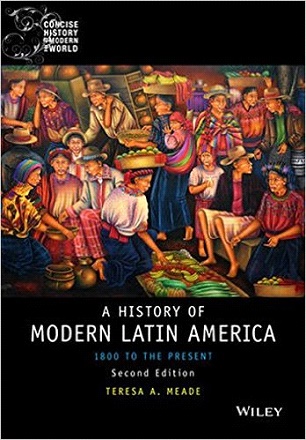 Abstract: A History of Modern Latin America offers a comprehensive and accessible introduction to the rich cultural and political history of this vibrant region from the onset of independence to the present day. Abstract: A History of Modern Latin America offers a comprehensive and accessible introduction to the rich cultural and political history of this vibrant region from the onset of independence to the present day.
- Includes coverage of the recent opening of diplomatic relations between the U. S. and Cuba as well as a new chapter exploring economic growth and environmental sustainability
- Balances accounts of the lives of prominent figures with those of ordinary people from a diverse array of social, racial, and ethnic backgrounds
- Features first-hand accounts, documents, and excerpts from fiction interspersed throughout the narrative to provide tangible examples of historical ideas
- Examines gender and its influence on political and economic change and the important role of popular culture, including music, art, sports, and movies, in the formation of Latin American cultural identity
- Includes all-new study questions and topics for discussion at the end of each chapter, plus comprehensive updates to the suggested readings
| | 30. How long will South Africa survive?: the looming crisisR.W. Johnson - London: Hurts & Company, 2015 |  Abstract: In 1977, RW Johnson's best-selling How Long Will South Africa Survive? provided a controversial and highly original analysis of the survival prospects of the apartheid regime. Now, after more than twenty years of ANC rule, he believes the situation has become so critical that the question must be posed again. He moves from an analysis of Jacob Zuma's rule to the increasingly dire state of the South African economy, concluding that the country is heading towards a likely International Monetary Fund bail-out which will in turn lead to a regime change of some kind. Johnson's analysis is strikingly original and cogently argued. He has for several decades now been a senior international commentator on South African affairs, known for his lucid analysis and complete lack of deference towards the conventional wisdom. He writes without fear or favour. Abstract: In 1977, RW Johnson's best-selling How Long Will South Africa Survive? provided a controversial and highly original analysis of the survival prospects of the apartheid regime. Now, after more than twenty years of ANC rule, he believes the situation has become so critical that the question must be posed again. He moves from an analysis of Jacob Zuma's rule to the increasingly dire state of the South African economy, concluding that the country is heading towards a likely International Monetary Fund bail-out which will in turn lead to a regime change of some kind. Johnson's analysis is strikingly original and cogently argued. He has for several decades now been a senior international commentator on South African affairs, known for his lucid analysis and complete lack of deference towards the conventional wisdom. He writes without fear or favour. | | 31. Ibn al-'Arabi and Islamic intellectual culture: from mysticism to philosophy Caner K. Dagli - London: Routledge, 2016 | 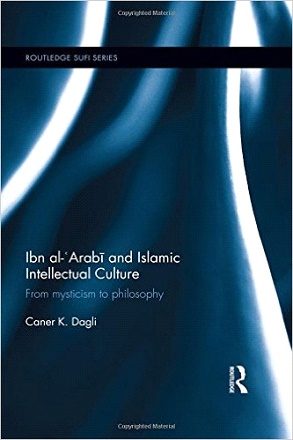 Abstract: Ibn al-'Arabī and Islamic Intellectual Culture traces the history of the concept of "oneness of being" (wahdat al-wujūd) in the school of Ibn al- 'Arabī, in order to explore the relationship between mysticism and philosophy in Islamic intellectual life. It examines how the conceptual language used by early mystical writers became increasingly engaged over time with the broader Islamic intellectual culture, eventually becoming integrated with the latter’s common philosophical and theological vocabulary. It focuses on four successive generations of thinkers (Sadr al-Dīn al-Qūnawī, Mu'ayyad al-Dīn al-Jandī). Abstract: Ibn al-'Arabī and Islamic Intellectual Culture traces the history of the concept of "oneness of being" (wahdat al-wujūd) in the school of Ibn al- 'Arabī, in order to explore the relationship between mysticism and philosophy in Islamic intellectual life. It examines how the conceptual language used by early mystical writers became increasingly engaged over time with the broader Islamic intellectual culture, eventually becoming integrated with the latter’s common philosophical and theological vocabulary. It focuses on four successive generations of thinkers (Sadr al-Dīn al-Qūnawī, Mu'ayyad al-Dīn al-Jandī). | | 32. Imperial China 1350-1990 / Porter, Jonathan Porter - London: Rowman & Littlefield, 2016 |  Abstract: This clear and engaging book provides a concise overview of the Ming-Qing epoch (1368–1912), China’s last imperial age. Beginning with the end of the Mongol domination of China in 1368, this five-century period was remarkable for its continuity and stability until its downfall in the Revolution of 1911. Viewing the Ming and Qing dynasties as a coherent era characterized by the fruition of diverse developments from earliest times, Jonathan Porter traces the growth of imperial autocracy, the role of the educated Confucian elite as custodians of cultural authority, the significance of ritual as the grounding of political and social order, the tension between monarchy and bureaucracy in political discourse, the evolution of Chinese cultural identity, and the perception of the “barbarian” and other views of the world beyond China. As the climax of traditional Chinese history and the harbinger of modern China in the twentieth century, Porter argues that imperial China must be explored for its own sake as well as for the essential foundation it provides in understanding contemporary China, and indeed world history writ large. Abstract: This clear and engaging book provides a concise overview of the Ming-Qing epoch (1368–1912), China’s last imperial age. Beginning with the end of the Mongol domination of China in 1368, this five-century period was remarkable for its continuity and stability until its downfall in the Revolution of 1911. Viewing the Ming and Qing dynasties as a coherent era characterized by the fruition of diverse developments from earliest times, Jonathan Porter traces the growth of imperial autocracy, the role of the educated Confucian elite as custodians of cultural authority, the significance of ritual as the grounding of political and social order, the tension between monarchy and bureaucracy in political discourse, the evolution of Chinese cultural identity, and the perception of the “barbarian” and other views of the world beyond China. As the climax of traditional Chinese history and the harbinger of modern China in the twentieth century, Porter argues that imperial China must be explored for its own sake as well as for the essential foundation it provides in understanding contemporary China, and indeed world history writ large. | | 33. India and Africa's partnership: a vision for a new future / Ed. by Ajay Kumar Dubey and Aparajita Biswas - New York: Springer, 2016 |  Abstract: This book demonstrates the changing dynamics of India’s engagement with Africa, focusing on trade, investment, official development assistance, capacity building activities and the diaspora. It also examines its impact at the economic, political and societal levels with respect to governance, democratic structures, education and health. India has competitive edge of historical goodwill and it is one of the most important countries engaging Africa in the 21st Century. For Africa, India has emerged from an aid recipient country to a major aid provider but on a basis of partnership model. Abstract: This book demonstrates the changing dynamics of India’s engagement with Africa, focusing on trade, investment, official development assistance, capacity building activities and the diaspora. It also examines its impact at the economic, political and societal levels with respect to governance, democratic structures, education and health. India has competitive edge of historical goodwill and it is one of the most important countries engaging Africa in the 21st Century. For Africa, India has emerged from an aid recipient country to a major aid provider but on a basis of partnership model. | | 34. India and the responsibility to protect / Alan Bloomfield - England: Ashgate, 2016 | 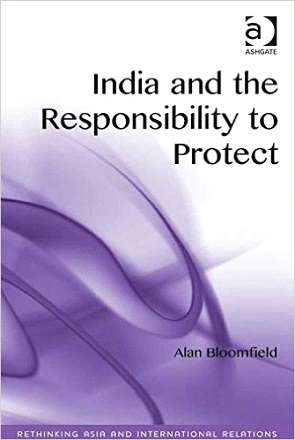 Abstract: Bloomfield charts India’s profoundly ambiguous engagement with the thorny problem of protecting vulnerable persons from atrocities without fatally undermining the sovereign state system, a matter which is now substantially shaped by debates about the responsibility to protect (R2P) norm. Books about India’s evolving role in world affairs and about R2P have proliferated recently, but this is the first to draw these two debates together. It examines India’s historical responses to humanitarian crises, starting with the 1971 Bangladesh Liberation War, concentrating on the years 2011 and 2012 when India sat on the UN Security Council. Three serious humanitarian crises broke during its tenure - in Côte d'Ivoire, Libya and Syria - which collectively sparked a ferocious debate within India. The book examines what became largely a battle over ’what sort of actor’ modern India is, or should be, to determine how this contest shaped both India’s responses to these humanitarian tragedies and also the wider debates about rising India’s international identity. The book’s findings also have important (and largely negative) implications for the broader effort to make R2P a recognised and actionable international norm. Abstract: Bloomfield charts India’s profoundly ambiguous engagement with the thorny problem of protecting vulnerable persons from atrocities without fatally undermining the sovereign state system, a matter which is now substantially shaped by debates about the responsibility to protect (R2P) norm. Books about India’s evolving role in world affairs and about R2P have proliferated recently, but this is the first to draw these two debates together. It examines India’s historical responses to humanitarian crises, starting with the 1971 Bangladesh Liberation War, concentrating on the years 2011 and 2012 when India sat on the UN Security Council. Three serious humanitarian crises broke during its tenure - in Côte d'Ivoire, Libya and Syria - which collectively sparked a ferocious debate within India. The book examines what became largely a battle over ’what sort of actor’ modern India is, or should be, to determine how this contest shaped both India’s responses to these humanitarian tragedies and also the wider debates about rising India’s international identity. The book’s findings also have important (and largely negative) implications for the broader effort to make R2P a recognised and actionable international norm. | | 35. India-Iran relations: progress, problems and prospects / Sujata Ashwarya - New Delhi: KW Publishers, 2016 |  Abstract: This book examines India’s relationship with Iran since the post-World War II period and its unique search for meaningful bilateral ties in the West Asian region in the context of the changing regional and international scenarios. The four chapters highlight the achievements and constraints on the development of Indo-Iranian relations during the Cold War era; opportunities and limitations in bilateral engagements between India and Iran in the aftermath of the Cold War; impact of the ‘US factor’ on the development of crucial Indo-Iranian energy ties and the limitation imposed by India’s relations with Israel and Saudi Arabia on the India–Iran ties. More specifically, the four chapters touch on the central drivers—energy imports, access to Central Asia, cooperation in Afghanistan, mutual trade and economic investments and security ties—of India’s Iran policy, and how they structure India’s interaction with the other countries of the region and impact on the articulation of national interests. Combining a rich interplay of facts and figures with nuanced analyses, this volume will be a valuable resource for scholars, policymakers, diplomats and any interested reader desirous of knowing more about Indo-Iranian relations in particular and India’s West Asia policy in general. Abstract: This book examines India’s relationship with Iran since the post-World War II period and its unique search for meaningful bilateral ties in the West Asian region in the context of the changing regional and international scenarios. The four chapters highlight the achievements and constraints on the development of Indo-Iranian relations during the Cold War era; opportunities and limitations in bilateral engagements between India and Iran in the aftermath of the Cold War; impact of the ‘US factor’ on the development of crucial Indo-Iranian energy ties and the limitation imposed by India’s relations with Israel and Saudi Arabia on the India–Iran ties. More specifically, the four chapters touch on the central drivers—energy imports, access to Central Asia, cooperation in Afghanistan, mutual trade and economic investments and security ties—of India’s Iran policy, and how they structure India’s interaction with the other countries of the region and impact on the articulation of national interests. Combining a rich interplay of facts and figures with nuanced analyses, this volume will be a valuable resource for scholars, policymakers, diplomats and any interested reader desirous of knowing more about Indo-Iranian relations in particular and India’s West Asia policy in general. | | 36. India migration report 2015: gender and migration / Edited by S. Irudaya Rajan - London: Routledge, 2016 |  Abstract: This volume studies important issues such as irregular migration, marriage migration and domestic labour migration, as well as the interconnections of migration, gender and caste; This volume highlights the relationship between economics and changing gender dynamics brought about by migration; and documents first-hand experiences of migrants from across India. Part of the prestigious annual series, this work will be useful to scholars and researchers of development studies, economics, migration and diaspora studies, and sociology. It will also interest policy-makers and government institutions working in the area. Abstract: This volume studies important issues such as irregular migration, marriage migration and domestic labour migration, as well as the interconnections of migration, gender and caste; This volume highlights the relationship between economics and changing gender dynamics brought about by migration; and documents first-hand experiences of migrants from across India. Part of the prestigious annual series, this work will be useful to scholars and researchers of development studies, economics, migration and diaspora studies, and sociology. It will also interest policy-makers and government institutions working in the area. | | 37. India's Foreign policy: coping with the changing world / Muchkund Dubey - New Delhi: Orient BlackSwan, 2016 |  Abstract: India´s Foreign Policy: Coping with the Changing World traces the values and principles that have shaped India´s foreign policy and its evolution starting from the Non-Aligned Movement, up to the end of the Cold War; decline of multilateralism and the nation state; and the challenges of globalization. It also looks at India´s relations with world powers like the United States, Russia, China and Japan, and with its neighbours, particularly Bangladesh and Pakistan. It further analyzes and suggests appropriate strategies for dealing with recent developments that have far-reaching consequences for India in the coming years. This updated edition includes a new chapter on Pakistan. Abstract: India´s Foreign Policy: Coping with the Changing World traces the values and principles that have shaped India´s foreign policy and its evolution starting from the Non-Aligned Movement, up to the end of the Cold War; decline of multilateralism and the nation state; and the challenges of globalization. It also looks at India´s relations with world powers like the United States, Russia, China and Japan, and with its neighbours, particularly Bangladesh and Pakistan. It further analyzes and suggests appropriate strategies for dealing with recent developments that have far-reaching consequences for India in the coming years. This updated edition includes a new chapter on Pakistan. | | 38. India's war: the making of modern South Asia 1939-1945 / Srinath Raghavan - Gurgaon: Allen Lane, 2016 |  Abstract: Between 1939 and 1945 India changed to an extraordinary extent. Millions of Indians suddenly found themselves as soldiers, fighting in Europe and North Africa but also - something simply never imagined - against a Japanese army threatening to invade eastern India. Many more were pulled into the vortex of wartime mobilization. Srinath Raghavan's compelling and original book gives both a surprising new account of the fighting and of life on the home front. For Indian nationalists the war has tended to be seen as a distraction from the quest for national independence - but Raghavan shows that in fact the war lay at the very heart of how and why colonial rule ended in South Asia. By seeing the Second World War through Indian eyes, Raghavan transforms our understanding of the conflict - with famous battles such as those in North Africa and Iraq reinterpreted, as well as fascinating and little known campaigns such as the destruction of Italian northeast Africa. Time and again, it was Indian troops that made Britain into a global power and, as the war came to an end, it was the Indian army that fought the final battles which marked the end both of the Japanese empire, and of the British. Abstract: Between 1939 and 1945 India changed to an extraordinary extent. Millions of Indians suddenly found themselves as soldiers, fighting in Europe and North Africa but also - something simply never imagined - against a Japanese army threatening to invade eastern India. Many more were pulled into the vortex of wartime mobilization. Srinath Raghavan's compelling and original book gives both a surprising new account of the fighting and of life on the home front. For Indian nationalists the war has tended to be seen as a distraction from the quest for national independence - but Raghavan shows that in fact the war lay at the very heart of how and why colonial rule ended in South Asia. By seeing the Second World War through Indian eyes, Raghavan transforms our understanding of the conflict - with famous battles such as those in North Africa and Iraq reinterpreted, as well as fascinating and little known campaigns such as the destruction of Italian northeast Africa. Time and again, it was Indian troops that made Britain into a global power and, as the war came to an end, it was the Indian army that fought the final battles which marked the end both of the Japanese empire, and of the British. | | 39. The India-US partnership: $1 trillion by 2030 / Nish Acharya - New Delhi: Oxford University Press, 2016 |  Abstract: The story of USA India relations is one of unfulfilled potential. Despite their common commitment to democracy, diversity, and free markets, their short- and long-term objectives have not aligned in a way to create a robust economic and political partnership. These two nations, which will soon be the second and the third largest economies in the world, must find ways to increase their economic integration over the next 15 years a through institutional capacity building, creating a startup culture, and using India as talent pool to resolve complex global problems. Engaging the question of bilateral partnership from the perspectives of investment, public policy, and philanthropy, Acharya delves into ways in which India can approach the goal of $1 trillion worth of economic ties with the US by 2030. Backed by 62 interviews of leaders from business, government, civil society, and the academia, and 30 case studies on the growing impact of American organizations on the Indian economy and of Indians on the American economy, this study highlights organizations that are inspirational models for their sectors and are aiming at realizing a trillion-dollar, long-term economic partnership between India and America. Abstract: The story of USA India relations is one of unfulfilled potential. Despite their common commitment to democracy, diversity, and free markets, their short- and long-term objectives have not aligned in a way to create a robust economic and political partnership. These two nations, which will soon be the second and the third largest economies in the world, must find ways to increase their economic integration over the next 15 years a through institutional capacity building, creating a startup culture, and using India as talent pool to resolve complex global problems. Engaging the question of bilateral partnership from the perspectives of investment, public policy, and philanthropy, Acharya delves into ways in which India can approach the goal of $1 trillion worth of economic ties with the US by 2030. Backed by 62 interviews of leaders from business, government, civil society, and the academia, and 30 case studies on the growing impact of American organizations on the Indian economy and of Indians on the American economy, this study highlights organizations that are inspirational models for their sectors and are aiming at realizing a trillion-dollar, long-term economic partnership between India and America. | | 40. India-US relations in the age of uncertainty: an uneasy courtship / Jain, B. M. B. M. Jain - London: Routledge, 2016 |  Abstract: In the initial phase of the Obama administration, India’s ruling class and strategic community formed a perception that the spirit of strategic partnership between the two countries might be diluted on account of China looming large in the priorities of this administration. Despite occasional hiccups in their relationship, this perception was overshadowed by the administration’s recognition of India’s role as counterweight to China in the Asia-Pacific region. This book addresses and re-evaluates the perceptions, policies and perspectives of public policy makers and bureaucratic elites in both India and the US in setting and articulating the tone, tenor and substance of the multi-faceted ties between the two countries. The scope of the book is not exclusively limited to the bilateral relationship in the critical areas such as the Indo-US nuclear deal, defence, security and strategic partnership. Its concerns and ramifications are much wider in global and regional contexts, covering/involving security architecture in the Asia-Pacific region, the interface between terrorism and weapons of mass destruction (WMDs), China as a factor in India-US relations, and the fallout of the New Delhi-Washington partnership on South Asia Abstract: In the initial phase of the Obama administration, India’s ruling class and strategic community formed a perception that the spirit of strategic partnership between the two countries might be diluted on account of China looming large in the priorities of this administration. Despite occasional hiccups in their relationship, this perception was overshadowed by the administration’s recognition of India’s role as counterweight to China in the Asia-Pacific region. This book addresses and re-evaluates the perceptions, policies and perspectives of public policy makers and bureaucratic elites in both India and the US in setting and articulating the tone, tenor and substance of the multi-faceted ties between the two countries. The scope of the book is not exclusively limited to the bilateral relationship in the critical areas such as the Indo-US nuclear deal, defence, security and strategic partnership. Its concerns and ramifications are much wider in global and regional contexts, covering/involving security architecture in the Asia-Pacific region, the interface between terrorism and weapons of mass destruction (WMDs), China as a factor in India-US relations, and the fallout of the New Delhi-Washington partnership on South Asia | | 41. Indians in Singapore 1819-1945: Diaspora in the colonial port city / Rajesh Rai - New York: Oxford University Press, 2014 | 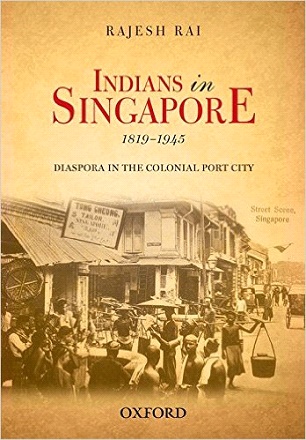 Abstract: Indians in Singapore, 1819 -1945 is the first comprehensive study of the Indian diaspora in colonial Singapore. Drawing on administrative archives, intelligence reports, observer accounts, newspapers, oral testimonies, and community-based records, the book provides a meticulous historical account of the formation of the diaspora in the colonial port-city, and its socio-political, religious and cultural development from the advent of British colonial rule to the end of the Japanese occupation. Indians in Singapore examines how the conditions of living as a minority in a multi-ethnic port-city; changes in colonial ideologies, administration and economy; developments in information-communication technologies; and transnational religious and socio-political currents in the late 19th and early 20th centuries, shaped Indian identity formations. What emerges is a fascinating account of how these Indian emigrants, by virtue of their unique vantage point in a frontier settlement that transformed into a metropolis of global significance, negotiated their position vis-a-vis the powers at hand and external processes in motion. In doing so, it reveals the distinct and complex nature of the historical journey of Indian migrants in the urban landscape of the colonial port-city - an aspect of diaspora studies that has received little attention in erstwhile scholarship. Abstract: Indians in Singapore, 1819 -1945 is the first comprehensive study of the Indian diaspora in colonial Singapore. Drawing on administrative archives, intelligence reports, observer accounts, newspapers, oral testimonies, and community-based records, the book provides a meticulous historical account of the formation of the diaspora in the colonial port-city, and its socio-political, religious and cultural development from the advent of British colonial rule to the end of the Japanese occupation. Indians in Singapore examines how the conditions of living as a minority in a multi-ethnic port-city; changes in colonial ideologies, administration and economy; developments in information-communication technologies; and transnational religious and socio-political currents in the late 19th and early 20th centuries, shaped Indian identity formations. What emerges is a fascinating account of how these Indian emigrants, by virtue of their unique vantage point in a frontier settlement that transformed into a metropolis of global significance, negotiated their position vis-a-vis the powers at hand and external processes in motion. In doing so, it reveals the distinct and complex nature of the historical journey of Indian migrants in the urban landscape of the colonial port-city - an aspect of diaspora studies that has received little attention in erstwhile scholarship. | | 42. Indigenization: key to self-sufficiency and strategic capability /Ranjit Ghosh - New Delhi: Pentagon Press, 2016 |  Abstract: The book attempts to study the defence industrialisation process that has been adopted by the militarily developed and developing nations to analyse, orient and adapt their best practices to the Indian defence industry and technological base. The analysis reveals that there is a requirement to re-assess, re-align & re-model the Indian defence industry apparatus in line with the vision of accelerating indigenisation, self-sufficiency and strategic capability, as pertaining to military systems. The book in its introductory chapter reviews the evolution and current realities of the Indian Defence Industry to arrive at the objective and scope of the research work. In the second chapter it reviews the journey of defence industrialisation in India up to 2015. Next, it reviews two fast-upcoming defence industries of Israel and South Korea to draw important takeaway’s for India. This is followed by analysing the international practices that have been adopted by the defence industry of two leading military nations i.e. the US and China. Such an analysis further brings out valuable defence industry experiences and vital lessons for the defence planners. The book in its concluding chapter suggests three plausible options for remodeling the Indian programme, discusses the most pragmatic option and the resultant feasible model in detail, recommends the way ahead for India before finally suggesting an action plan for MAKE IN INDIA in the Defence Sector. Abstract: The book attempts to study the defence industrialisation process that has been adopted by the militarily developed and developing nations to analyse, orient and adapt their best practices to the Indian defence industry and technological base. The analysis reveals that there is a requirement to re-assess, re-align & re-model the Indian defence industry apparatus in line with the vision of accelerating indigenisation, self-sufficiency and strategic capability, as pertaining to military systems. The book in its introductory chapter reviews the evolution and current realities of the Indian Defence Industry to arrive at the objective and scope of the research work. In the second chapter it reviews the journey of defence industrialisation in India up to 2015. Next, it reviews two fast-upcoming defence industries of Israel and South Korea to draw important takeaway’s for India. This is followed by analysing the international practices that have been adopted by the defence industry of two leading military nations i.e. the US and China. Such an analysis further brings out valuable defence industry experiences and vital lessons for the defence planners. The book in its concluding chapter suggests three plausible options for remodeling the Indian programme, discusses the most pragmatic option and the resultant feasible model in detail, recommends the way ahead for India before finally suggesting an action plan for MAKE IN INDIA in the Defence Sector. |
|
|